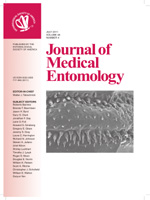Cimex lectularius L. (Hemiptera: Cimicidae) is a widespread blood feeding pest of humans around the world, including North America, and has recently undergone a resurgence. A molecular diagnostic technique applying multiplex polymerase chain reaction (PCR) was developed to distinguish bed bug eggs, leg fragments, and degraded samples from other arthropods that frequently occur in human dwellings. A 410-428-bp region of the mitochondrial DNA 16S rRNA gene was used. To design C. lectularius-specific PCR primers, DNA sequences of various bed bug samples from the United States, Canada, and Australia, along with sequences of other Cimicidae and arthropods that often occur in dwellings, were considered. Based on DNA sequence variation, one reverse PCR primer specific for C. lectularius was identified. Multiplex PCR using three primers will yield a 417- and 140-bp amplicon for C. lectularius and a single 410-428-bp amplicon for other taxa. This assay was successful in identifying C. lectularius eggs, leg fragments, and degraded samples. This technique should provide a reliable, quick, and economical technique for identifying C. lectularius, when morphological identification is not possible.
How to translate text using browser tools
1 July 2011
Multiplex Polymerase Chain Reaction Diagnostics of Bed Bug (Hemiptera: Cimicidae)
Allen L. Szalanski,
Amber D. Tripodi,
James W. Austin
ACCESS THE FULL ARTICLE
It is not available for individual sale.
This article is only available to subscribers.
It is not available for individual sale.
It is not available for individual sale.

Journal of Medical Entomology
Vol. 48 • No. 4
July 2011
Vol. 48 • No. 4
July 2011
bed bug
Cimex lectularius
mitochondrial DNA
molecular diagnostics
multiplex polymerase chain reaction




